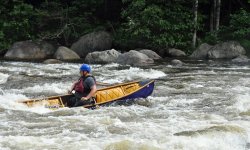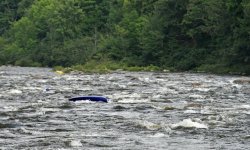There are rivers that aren’t too difficult if you take the right lines, but can be brutal if you don’t. I was on one of these rivers on Saturday – the Dead in ME, and I paid the price for a bad line on the last rapid - Lower Poplar. My first swim of the year.
The Dead is one of the longest continuous whitewater runs in the Northeast with approximately thirty rapids along a fourteen-mile stretch. The river is mostly boulder-type rapids with lots of holes and pour-overs. The release was supposed to be 2,400 cfs, but was closer to 2,100 cfs - a nice class II/III. We had 13 boats in our group – 6 canoes, 6 kayaks and 1 shredder.
It was a long trip down to Lower Poplar – over 5 hours with 3-swims, and everyone was tired. Lower Poplar is the last, and arguably the most difficult rapid on the river. The river turns right along a boulder garden as the water tumbles down the left side with huge wave trains and large holes. The kayakers usually run the left side, while open boaters usually run the right side along the seam between the boulder garden and the big holes.
As I was coming down the right side I saw one of the other open boaters flip in front of me. I got around him to the left, but now I was out in the big holes and pour-overs. Before long, my boat was full of water and I was struggling to keep it upright, never mind avoiding the rocks and holes. About half way down, I went sideways over a large rock into a hole, and over I went.
As I swam downstream I looked back to see my canoe still stuck in the hole. That was the least of my problems. Swimming through rapids is something that I try to practice, but it doesn’t match the real experience. First, I swam though a series of “haystacks” or standing waves where you have to breathe in the trough, and hold your breath as you go through the wave - breathe, glug, breathe, glug, breathe, glug.
After the waves, I could see a horizon line downstream indicating that I was approaching a rock with a hole on the other side. I tucked into a ball as best I could as I went into the hole. When I came out the other side Paul was yelling at me to swim hard to the left shore since I was approaching another big hole. I wasn’t making much progress so I threw away my paddle thinking that would allow me to swim better. After more waves, more rocks and more holes, I finally got myself to shore. It was about a 200-yard swim, but it seemed like forever.
I had paddled through 30 rapids in 14-miles only to swim the last 200-yards. We had 3 other open boaters in our group swim this rapid, so I guess I shouldn't feel too bad.
Full trip report here:

 eckilson.blogspot.com
eckilson.blogspot.com
The Dead is one of the longest continuous whitewater runs in the Northeast with approximately thirty rapids along a fourteen-mile stretch. The river is mostly boulder-type rapids with lots of holes and pour-overs. The release was supposed to be 2,400 cfs, but was closer to 2,100 cfs - a nice class II/III. We had 13 boats in our group – 6 canoes, 6 kayaks and 1 shredder.
It was a long trip down to Lower Poplar – over 5 hours with 3-swims, and everyone was tired. Lower Poplar is the last, and arguably the most difficult rapid on the river. The river turns right along a boulder garden as the water tumbles down the left side with huge wave trains and large holes. The kayakers usually run the left side, while open boaters usually run the right side along the seam between the boulder garden and the big holes.
As I was coming down the right side I saw one of the other open boaters flip in front of me. I got around him to the left, but now I was out in the big holes and pour-overs. Before long, my boat was full of water and I was struggling to keep it upright, never mind avoiding the rocks and holes. About half way down, I went sideways over a large rock into a hole, and over I went.
As I swam downstream I looked back to see my canoe still stuck in the hole. That was the least of my problems. Swimming through rapids is something that I try to practice, but it doesn’t match the real experience. First, I swam though a series of “haystacks” or standing waves where you have to breathe in the trough, and hold your breath as you go through the wave - breathe, glug, breathe, glug, breathe, glug.
After the waves, I could see a horizon line downstream indicating that I was approaching a rock with a hole on the other side. I tucked into a ball as best I could as I went into the hole. When I came out the other side Paul was yelling at me to swim hard to the left shore since I was approaching another big hole. I wasn’t making much progress so I threw away my paddle thinking that would allow me to swim better. After more waves, more rocks and more holes, I finally got myself to shore. It was about a 200-yard swim, but it seemed like forever.
I had paddled through 30 rapids in 14-miles only to swim the last 200-yards. We had 3 other open boaters in our group swim this rapid, so I guess I shouldn't feel too bad.
Full trip report here:

Dead - Spencer Stream to West Forks - August 9, 2025
My boat is loaded There are rivers that aren’t too difficult if you take the right lines, but can be brutal if you don’t. I was on one of th...
Last edited:


